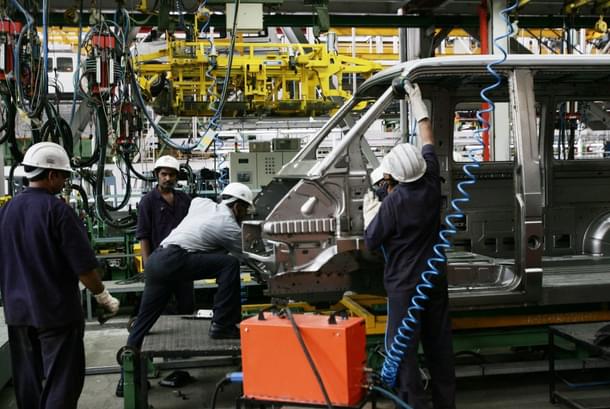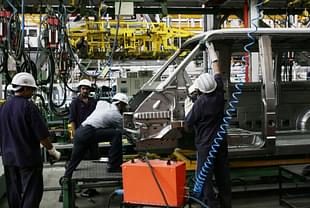Economy
Auto-Immobile: The Vehicles Sector Is Failing Not Just Due To Recession, But Owing To Greed And A Refusal To Reform
Satish Viswanathan
Aug 25, 2019, 11:44 AM | Updated 11:44 AM IST
Save & read from anywhere!
Bookmark stories for easy access on any device or the Swarajya app.


As the July figures of automobile sales in India emerged, a picture of gloom and doom started taking shape. Passenger vehicle sales were estimated to have declined by 31 per cent to approximately 2 lakh units. This fall is the steepest ever and far exceeds the 24 per cent dip in sales in November 2008, which happened to coincide with the global recession.
Regarded as one of the bellwethers of the Indian economy, the automobile sector is in the throes of its worst crisis. Poor sales has resulted in 245 passenger vehicle dealerships shutting shop across the country in the last 18 months. More than 5,000 contract workers were laid off in production units in Tamil Nadu in the last quarter.
As many as 40,000-50,000 workers have been retrenched in the Gurugram-Manesar auto belt. A number of economic analysts have argued that the crisis in the automobile sector is primarily due to the government’s inability to redress the liquidity crunch and dampened economic growth.
This is said to have stifled the purchasing power of the potential vehicle buyer, thereby causing a massive dip in demand. While macro-economic factors and the ongoing global recession have indeed had some impact on automobile sales, how much of the current crisis is it of the industry’s own making? Are there other external factors which have had an equally big impact?
Greed In The End Hits The Greedy
The Indian automobile market witnessed a phenomenal rise in the last 15 years. The aspirational value of owning a car coupled with rising disposable incomes aided the growth of the sector beyond the tier-1 cities. Manufacturers, both Indian and foreign, rode the wave and went on a massive expansion spree.
Tier-2 and 3 cities saw thousands of new dealerships being set up. State-of-the-art manufacturing facilities were established across the country and India emerged as a major export hub in Asia.
But have their products evolved technologically during the same time period? Maruti Suzuki introduced the 1.3-litre Fiat-sourced engine in the first generation Swift in 2007. It has used the exact same engine, albeit in different states of tune, in all its cars over the last 12 years.
Other car manufacturers have also been milking dry the same technology without investing adequately into research and development. Engine technology has remained stagnant over the last decade. Build quality of cars sold in India has seen no ground breaking improvements. The only thing which has soared north is the price of cars.
One of the cheapest A-segment cars currently available in the Indian market is the Datsun Redi-GO, which has an ex-showroom price of around Rs 4 lakh. However, this car scored 0 out of 5 in the ODB54 crash test. Maruti Suzuki and Renault also offer entry hatchbacks costing less than Rs 5 lakh.
These offerings have age-old engine technology, poor sheet metal quality and have little or no safety features. In short, these “entry level affordable hatchbacks” are flimsy tin cans on wheels masquerading as cars.
Even the higher segments have witnessed something similar. Toyota Innova is one of the largest selling Multi-Purpose Vehicles (MPV) in the Indian market and is credited with reviving Toyota’s fortunes at a time when the Japanese major was staring at an exit from the Indian market.
The first generation of the car was launched in 2005 at an ex-showroom price of under Rs 10 lakh. The top end variant of the latest generation of the Toyota Innova (labelled Crysta) costs an eye- watering Rs 28 lakh on road.
Barring a slightly modified engine and updates to both the interiors/exteriors, the car’s architecture has not undergone any sort of radical change which justifies a threefold hike in price (even after factoring in inflation and higher input costs).
For years, car manufacturers in India managed to pull wool over the eyes of the first-time car buyer.
The buyer has become a little more discerning and prefers to put her money only when there is a semblance of value on offer. Not only has this greedy pricing model kept customers away, it has also allowed the used car market to blossom. The insatiable greed of the auto majors is now threatening to consume them.
Growth Of App-Based Taxis
A car owner in any of the tier-1 cities in India has to contend with crumbling roads, ever present traffic congestion, paucity of parking space and finally the stress of driving on crowded roads. Car ownership in an urban setting is not an attractive proposition to the under-30-year-olds.
This demographic constitutes a big chunk of first-time car buyers and these external factors are deterring them from splashing the cash. More importantly, app-based taxi services offer the potential car owner a more attractive proposition. Why go through the hassle of buying a car when you can be chauffeured around town at a significantly lower cost?
Car ownership is no longer a status symbol as it was two decades ago. The head rules over the heart. Ola/Uber are here to stay and automakers will have to live with this reality.
BS-VI Adoption
With the sixth stage of the Bharat Stage emission norms set to kick in from 1 April 2020, manufacturers are facing a double whammy. Not only will they have to overhaul existing infrastructure to make new vehicles compliant, there is also the pressing issue of BS IV compliant vehicles piling up at the dealership level.
With customers preferring to wait for the BS VI vehicles to become available, large inventories will hit dealers.
According to ICRA, Non-Banking Financial Companies (NBFCs) fund 30 per cent of passenger cars and nearly 65 per cent of two-wheelers.
Following the dramatic fall of IL&FS in 2018, NBFCs have also limited their exposure to the auto sector. The fall in sales coupled with the absence of easy financing has forced hundreds of dealers across the country to shut shop.
With no silver lining in sight, the Society of Indian Automobile Manufacturers (SIAM) called upon the Finance Minister to cut GST on automobiles from 28 per cent to 18 per cent in order to spur demand. Strangely enough, it never seems to have occurred to the manufacturers that cutting prices by 8-10 per cent would also lead to increased footfalls at the dealers.
For far too long, the customer has had to bear the brunt of repeated price hikes and “increased input costs”. The auto sector has had a field day selling substandard products at atrocious prices.
With the customer becoming more aware and other alternatives to a personal vehicle emerging, this free run is finally coming to an end. If “achche din” have to return to the sector, manufacturers will have to go back to the drawing board.
Satish Viswanathan tweets at @satishv1987.




